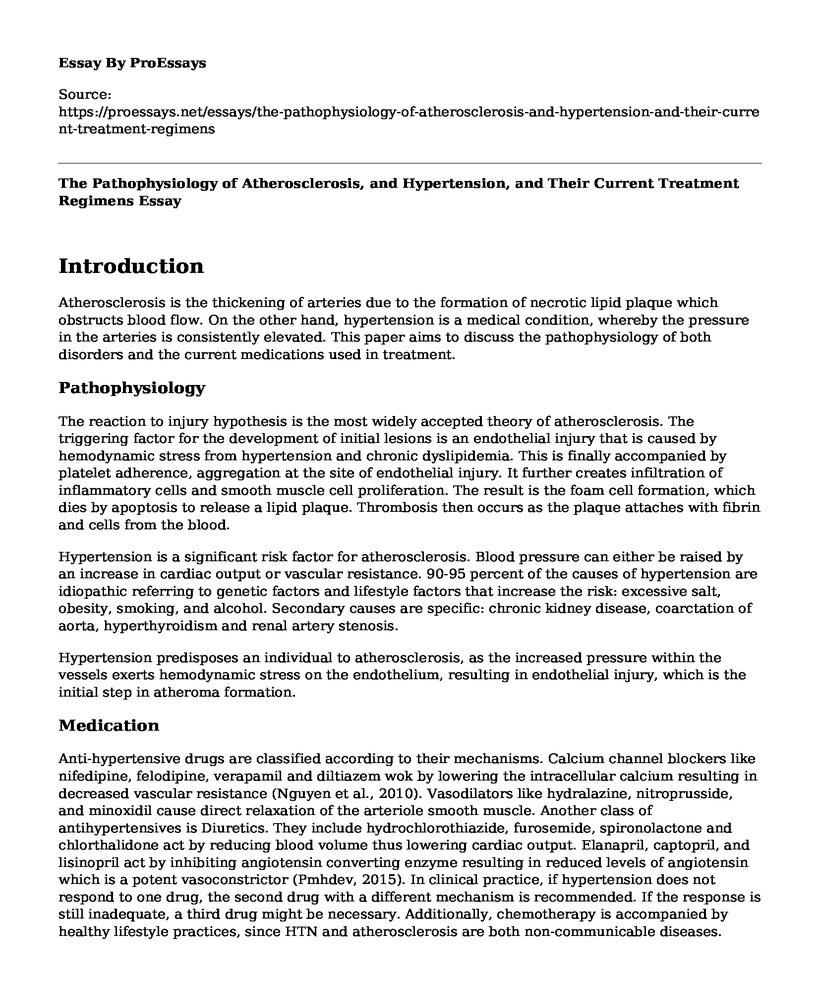Introduction
Atherosclerosis is the thickening of arteries due to the formation of necrotic lipid plaque which obstructs blood flow. On the other hand, hypertension is a medical condition, whereby the pressure in the arteries is consistently elevated. This paper aims to discuss the pathophysiology of both disorders and the current medications used in treatment.
Pathophysiology
The reaction to injury hypothesis is the most widely accepted theory of atherosclerosis. The triggering factor for the development of initial lesions is an endothelial injury that is caused by hemodynamic stress from hypertension and chronic dyslipidemia. This is finally accompanied by platelet adherence, aggregation at the site of endothelial injury. It further creates infiltration of inflammatory cells and smooth muscle cell proliferation. The result is the foam cell formation, which dies by apoptosis to release a lipid plaque. Thrombosis then occurs as the plaque attaches with fibrin and cells from the blood.
Hypertension is a significant risk factor for atherosclerosis. Blood pressure can either be raised by an increase in cardiac output or vascular resistance. 90-95 percent of the causes of hypertension are idiopathic referring to genetic factors and lifestyle factors that increase the risk: excessive salt, obesity, smoking, and alcohol. Secondary causes are specific: chronic kidney disease, coarctation of aorta, hyperthyroidism and renal artery stenosis.
Hypertension predisposes an individual to atherosclerosis, as the increased pressure within the vessels exerts hemodynamic stress on the endothelium, resulting in endothelial injury, which is the initial step in atheroma formation.
Medication
Anti-hypertensive drugs are classified according to their mechanisms. Calcium channel blockers like nifedipine, felodipine, verapamil and diltiazem wok by lowering the intracellular calcium resulting in decreased vascular resistance (Nguyen et al., 2010). Vasodilators like hydralazine, nitroprusside, and minoxidil cause direct relaxation of the arteriole smooth muscle. Another class of antihypertensives is Diuretics. They include hydrochlorothiazide, furosemide, spironolactone and chlorthalidone act by reducing blood volume thus lowering cardiac output. Elanapril, captopril, and lisinopril act by inhibiting angiotensin converting enzyme resulting in reduced levels of angiotensin which is a potent vasoconstrictor (Pmhdev, 2015). In clinical practice, if hypertension does not respond to one drug, the second drug with a different mechanism is recommended. If the response is still inadequate, a third drug might be necessary. Additionally, chemotherapy is accompanied by healthy lifestyle practices, since HTN and atherosclerosis are both non-communicable diseases.
Conclusion
In summary, clinicians should be conversant with the pathophysiology of atherosclerosis and hypertension and the drugs for treatment. Most importantly, they should advise the patient's to avoiding stress and the importance of exercises.
References
Nguyen,, Q., Dominguez, J., Nguyen,, L., & Gullapalli, N. (2010, January). Hypertension Management: An Update. Retrieved from https://www.ncbi.nlm.nih.gov/pmc/articles/PMC4106550/Pmhdev. (2015, July 1).
What medications are used to treat high blood pressure? - PubMed Health - National Library of Medicine - PubMed Health. Retrieved from https://www.ncbi.nlm.nih.gov/pubmedhealth/PMH0072414/
Cite this page
The Pathophysiology of Atherosclerosis, and Hypertension, and Their Current Treatment Regimens. (2022, May 17). Retrieved from https://proessays.net/essays/the-pathophysiology-of-atherosclerosis-and-hypertension-and-their-current-treatment-regimens
If you are the original author of this essay and no longer wish to have it published on the ProEssays website, please click below to request its removal:
- Annotated Bibliography Example on Ethical Issues in Medicine
- Do Cell Phones Cause Cancer?
- Health Problems Among Seniors Essay
- Was Ruth Sparrow Wrong to Try to Sell Her Kidney? - Essay Sample
- Essay Sample on Old Age: Prolonging Life with Technology
- Essay Sample on Pediatric Hospitalization: Challenges & Expenses of Rare Diseases
- Essay Example on EHCR: Improving Healthcare Quality and Efficiency







